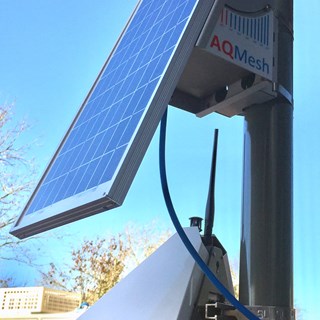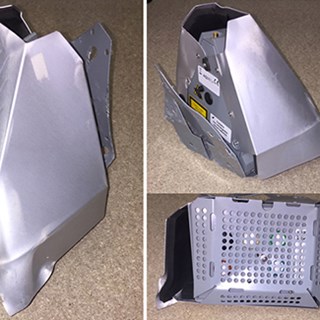There’s no doubt that small sensor systems can have an advantage over their cumbersome reference station cousins - in terms of maintenance requirements. We are often asked about ‘service’ requirements for our pods and the honest answer is that the default position, in normal working conditions, is ‘none’. However ..
Read MoreWe are often asked by customers whether AQMesh can operate in cold conditions. Long-term use at temperatures well below freezing, with ice and snowfall, is indeed challenging. Cold weather operation has been key to AQMesh – improved upon and proven in the field – for over 10 years. The main features, described below, have been most recently been put to the test in Iceland.
Read MoreA UK local authority installed nine AQMesh systems at different points across a busy town, measuring nitrogen dioxide (NO2) at 15 minute intervals, monitoring 24/7. These locations were established monitoring points, where measurements had been taken previously using diffusion tubes, limited to one average reading every few weeks.
Read MoreIs it normal to get excited about a Publicly Available Standard? For us it feels like a long time coming, and this first step on the long road towards an ISO standard for small sensor air quality monitoring is very welcome.
Read MoreAutonomous power can make all the difference in hyper-local air quality monitoring. With particulate matter sampling needing a little more power than passive gas sensors, solar is the go-to power option, rather than internal battery. Most systems require sufficiently little energy that they can be powered by a relatively small solar panel, but it’s the back-up power management that makes all the difference.
Read MoreFirst of all, you can’t calibrate using bottled gas, as with reference analysers. Even if you can create a chamber or manifold to pump gases through, electrochemical gas sensors do not respond in the same way to single, dry gases as they do to mixed gases in an ambient environment.
Read More2022 marked 10 years of innovation and leadership from AQMesh. To highlight the team’s experience, ongoing forward-thinking and its commitment to pushing the capabilities of small sensor systems, here are the top 10 things AQMesh developed first and refined since it commercially launched in 2012.
Read MoreMany small sensor air quality monitoring systems cannot reliably measure coarse particulate matter, or PM10, because of the technology they use. AQMesh’s proprietary optical particle counter (OPC) delivers high out-of-the-box accuracy across all key particle matter (PM) fractions thanks to its bespoke, in-house design.
Read MoreData collected as part of the UKRI SPF Clean Air Program has proven that AQMesh out-of-the-box performance for PM2.5 exceeds new US EPA targets, with excellent results for PM1 and PM10 as well.
Read MoreThe new AQMesh LTE CAT M1 modem uses the latest LTE (Long Term Evolution) communications standard, including support for NB-IoT (machine-to-machine).
Read MoreSmall sensor air quality monitoring devices can be mounted flexibly, offering localised air quality information and data analysis, but they vary in what they can measure, how accurately they measure it, and how readings are accessed by users. Critically they also vary in terms of the reliability of data delivery.
Read MoreRefinement and development of the AQMesh small sensor air quality monitoring system over many years, and through numerous global co-location comparisons, brings a wealth of unique benefits.
Read MoreThe small sensor air quality monitoring world has moved on during the last three years and we have identified several new challenges and benefits relating to the continual development of air quality monitoring technology.
Read MoreThe results of the 2019 AIRLAB Microsensors Challenge* were revealed in Paris on 21st January and AQMesh was awarded the highest score for accuracy of all products presented for monitoring of outdoor air quality.
Read MoreWhilst not the only AQMesh pods still in regular use since the product was commercially launched in 2013, two AQMesh pods are still in use in Spain and demonstrate the long life of this small sensor air quality monitoring system.
Read MoreAQMesh was selected to be included in the 2017 Parliamentary Review as an industry leader within the environmental technology sector.
Read MoreAt the IAPSC in May 2017, Professor Rod Jones of the University of Cambridge presented his case study on large scale deployment of sensors, which included showing how AQMesh can be used to discriminate between local sources of pollution and regional sources of pollution.
Read MoreLeading small sensor air quality monitor, AQMesh, has recently been shown to work alongside passive samplers and air quality models, as well as complementing reference station networks.
Read MoreAt the RSC AAMG event on ‘Air Quality Monitoring: Evolving Issues and New Technologies’ Professor Rod Jones of the University of Cambridge presented a paper showing very encouraging results.
Read MoreAn AQMesh pod used in the recent Citi-Sense project in Norway was returned to us at the end of the project, and we were surprised at the condition.
Read MoreA new generation of air quality monitors is now being offered to provide localised, real-time air quality readings – but the potential benefit is only just starting to be realised.
Read MoreThe emergence of sensors capable of measuring the gases and particles that make up air pollution, especially in cities and industrial areas, has driven many academic studies which evaluate the sensors and compare performance against reference methodology.
Read More



























